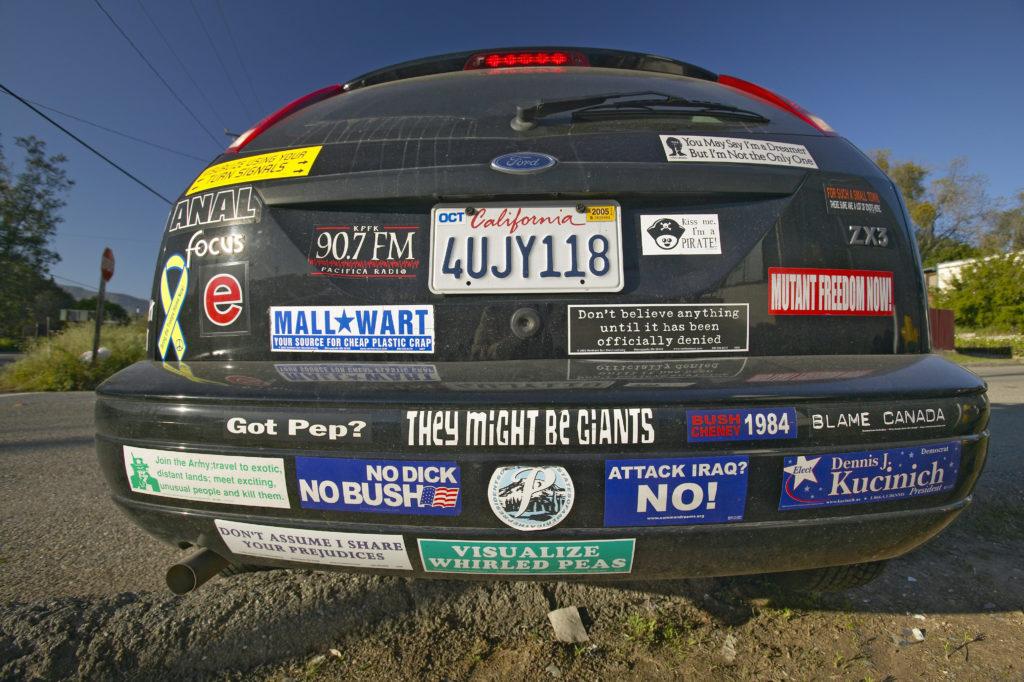
Apple’s newest tablets – the iPad Pro and iPad Air have already made lots of noise, thanks to the “Crushed” TV ads heralding their debut. (I blogged about the controversial spots last week, subsequently pulled by Apple as part of their television marketing campaign.)
But it turns out there’s something else that is stirring up vitriol from Apple fan boys and girls: the Apple stickers that have accompanied laptops, smartphones, and tablets since 1977 will no longer be included in the packaging.
Apple enthusiasts first noticed the missing stickers when purchasing a new Vision pro headset. And now the trend is continuing with the new tablets, leaving the Apple consumer community to conclude the famous stickers have been phased out.
9To5Mac calls it “a key piece of memorabilia” that will now be missing. In a memo to store employees – who will no doubt hear about the lack of these stickers from bummed-out fans – the company cites “environmental goals” as the culprit.
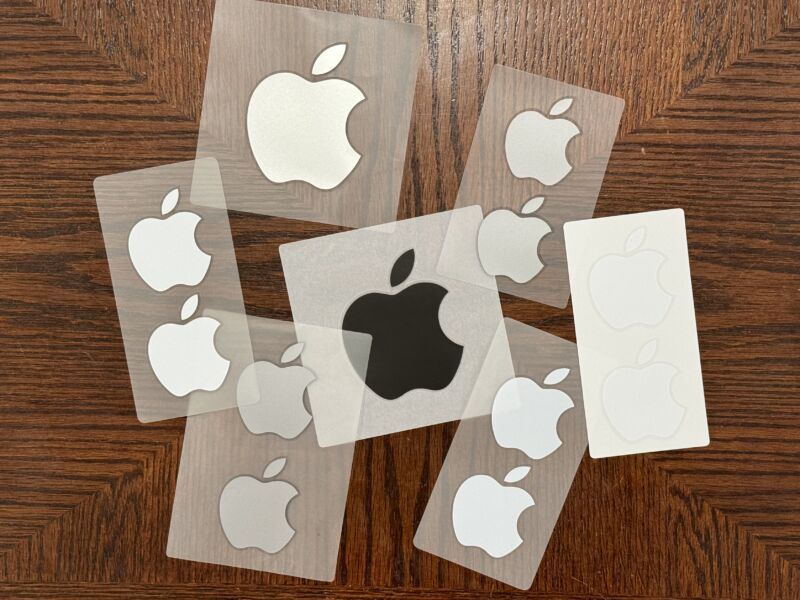
As Ars Technica’s Andrew Cunningham reports, “the new normal” will now be stickers-upon request at Apple Stores. The stickers, however, will not be available if an Apple purchase is made via Amazon, Best Buy, and other retailers.
Cunningham notes that when Apple was in the fledgling state back in the ’70s and ’80s, their core fans slapped the stickers on their cars and other places to support the “tech underdog.”
Apple has always allowed its rabid customers to share their love for this iconic brand, a symbol of American innovation and technology. Perhaps that’s about to change.
But Apple is apparently moving out of the “sticker phase,” and that got me wondering about how radio quietly did the same thing. It’s hard to pinpoint when station bumper stickers became an endangered promotional species. But my guess is that it started during the ’90s when marketing budgets were slashed during the early days of consolidation.
Many broadcasters reasoned that due to owning clusters of stations in most metros, the need to market all or some of them became less necessary. Others in the industry theorized that as car and truck bumpers transitioned from chrome to plastic, fewer drivers would willingly “deface” their vehicles with sticky station advertising.
I’m compelled to ask whether the disappearance of radio station bumper stickers from millions of car bumpers all over America hasn’t contributed – even in a tertiary way – to the industry’s “top-of-mind shortfall” we see playing out in the chart below from Techsurvey 2024. In a repeat question from four years earlier, we see the actual number of users of SiriusXM, Spotify, podcasts, and broadcast radio next to what core radio respondents estimated them to be.
While the other platforms are perceived to have more listeners than they actually do, AM/FM radio is the opposite, a deficit that has only grown from four years ago:
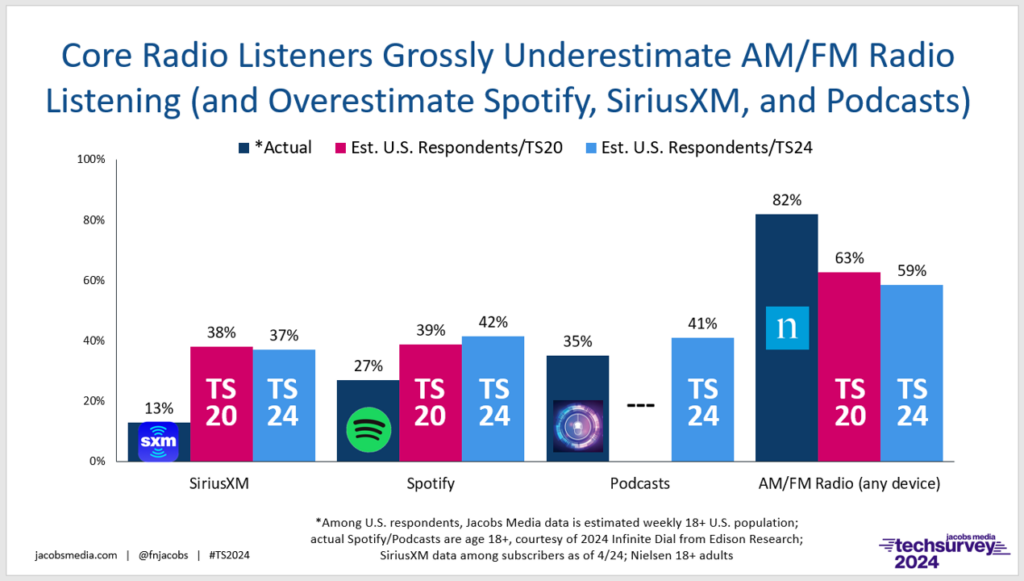
The more you see a brand being marketed, the deeper an imprint it makes. And while I’ve never seen research that backs this up, CGM – consumer generated marketing – always seems to have a bigger impact.
Bumper stickers fit the bill. Real people displaying your call letters on one of their most important possessions – their cars and trucks. And when a station does an especially good job of distributing its stickers, those little statements of pride that tell those around you about the station you identify with, it becomes even more powerful.
During those times I’ve worked with stations that gave the audience “permission” to display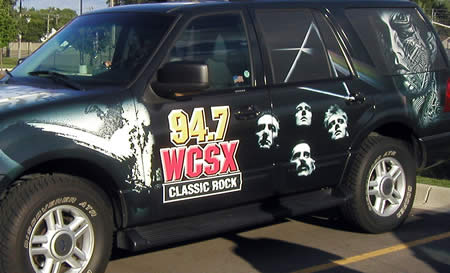 their brand, I’ve experienced impressive results. Bumper sticker promotions, those WCSX “Pace Cars” I highlighted here last month, and the “Expose the X” contest that 91X in San Diego pulled off with great success in the ’80s all leveraged listener passion.
their brand, I’ve experienced impressive results. Bumper sticker promotions, those WCSX “Pace Cars” I highlighted here last month, and the “Expose the X” contest that 91X in San Diego pulled off with great success in the ’80s all leveraged listener passion.
The 91X contest was always a favorite, mostly because it perfectly tapped into the insane creativity of the Alternative audience (although the slogan back then was “The Cutting Edge of Rock”).
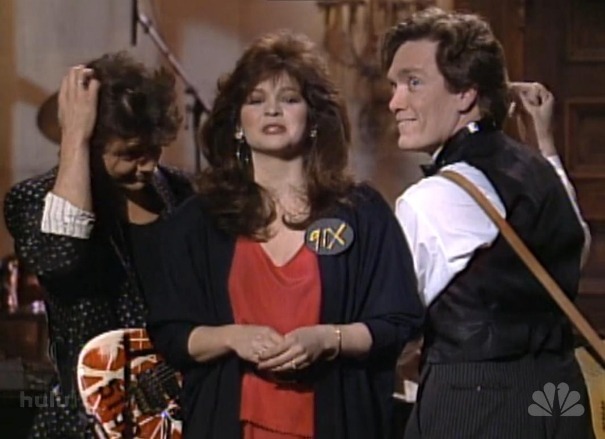 “Expose” garnered lots of local attention for the station as its logo began to appear all over San Diego…and beyond. The sides of barns, a banner stretched between two skydivers, a claymation TV ad that ended up on local TV, and in many other unlikely places.
“Expose” garnered lots of local attention for the station as its logo began to appear all over San Diego…and beyond. The sides of barns, a banner stretched between two skydivers, a claymation TV ad that ended up on local TV, and in many other unlikely places.
While it didn’t capture the grand prize, an inventive 91X listener convinced SNL guest host, Valerie Bertinelli, to wear a station pin for her network appearance. Suffice it to say we learned about the power of CGM way back in 1987.
Some of the best promotions I’ve ever experienced revolved around bumper stickers. In Detroit radio during those high-flying rock radio days when four “AOR” stations competed in daily trench wars for attention, bumper sticker visibility was often a key factor. You couldn’t help but notice the ranks of those stations – WRIF, W4, WABX, and WLLZ – often seemed to mirror their ability to get their stickers out.
When we made the discovery in the late ’70s that WRIF owned the oval/racetrack shape, it allowed us to put anything in the middle – band names, catch phrases, the area sports teams, and whatever people were buzzing about at that moment.
Savvy salespeople at the stations during those days sponsored the sticker backs, often with coupons that could be redeemed by listeners. How’s that for attribution?
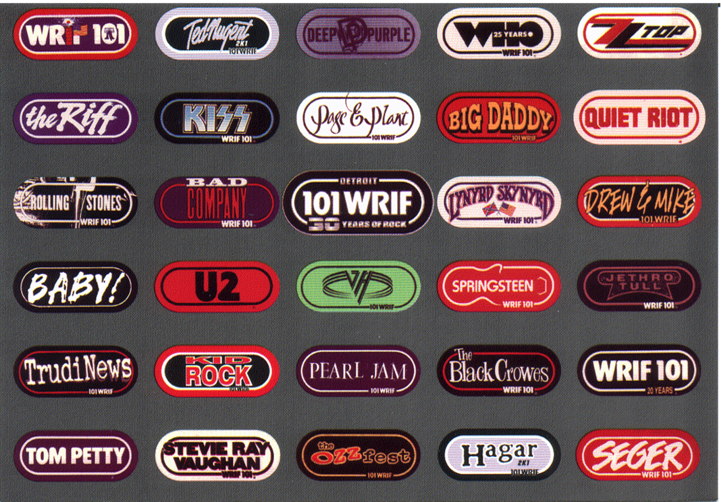
In the big scheme of radio things, station bumper stickers seem like a small, even obscure bit of the industry’s past. Among the other marketing tools that have faded over time, they are memories now, although there are still opportunistic entrepreneurs selling and reselling them on sites like eBay.
Could a strong radio station during the summer of 2024 resurrect bumper stickers for a “throwback” contest, complete with spotter vans and cash prizes? Would anyone even put a station sticker on their new Tahoe, Tesla, or Telluride? Would they be willing to “stick it and win?”
It is simply not possible to know the impact the station bumper sticker’s demise has had on the radio industry, if any. For people who have worked in the radio business during this millennium, bumper stickers have about as much relevance as the cart machine and the splicing block.
But as Apple now goes down this path, eliminating a form of customer expression and passion, it makes you wonder whether this decision isn’t just a bit short-sighted. The great sticker cancellation isn’t going to materially affect Apple in any measurable way. You probably won’t want to short your Apple stock.
Yet, in terms of distancing the customer from the brand, and perhaps tamping down the pride and even passion for Apple as a company people have loved to support, you wonder about the wisdom of this very simple decision.
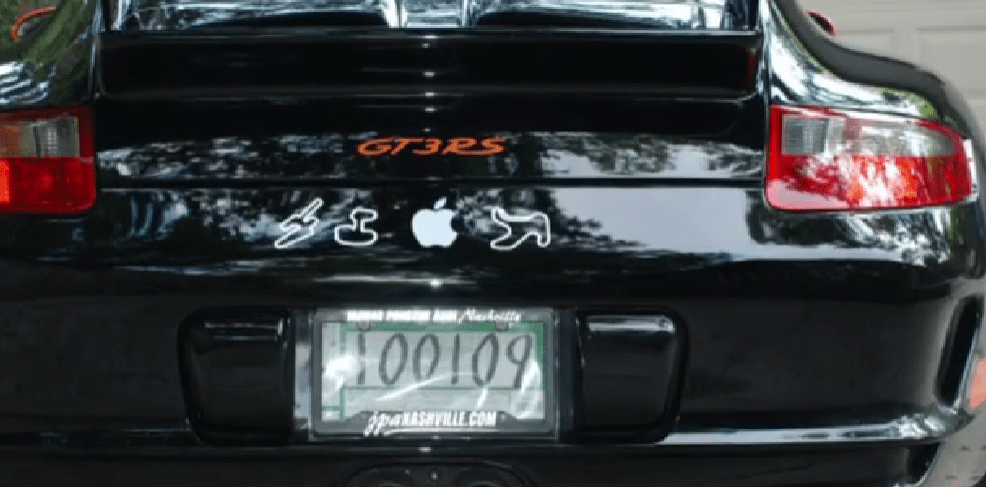
Did the sticker cancellation in radio begin the snowballing effect that has led to the industry’s erosion or the perception that “no one listens to the radio anymore?”
If you saw station bumper stickers, every day and everywhere you went, would it perhaps alter your perceptions about how many people actually listen to the radio? Could something so small actually have that big an effect?
In the last decade or so when stations broadcast on remote or showed up at an event, listeners would often ask if there were any free stickers or merch available.
In recent years, they’ve stopped asking. They know better.
Special thanks to 91X’s Josh Hammond, Gregg Wolfson, and Garett Michaels. – FJ
- Why Radio PDs Are A Lot Like NBA Coaches - May 8, 2025
- Memo To Radio: We Have Met The Enemy And It Is… - May 7, 2025
- The Guy In The Next Car - May 6, 2025




There are very few requests for stickers at least from my Merch Operation. with that said, there are new materials, and particularly adhesives that do not damage the new plastic bumpers. Even to cling stickers for glass.
Just saying.
We still do a summer sticker campaign in our small(ish) market. It’s not like the old days when it seemed like every car had a sticker, but it doesn’t suck to drive around and see a bunch of logos rolling around!
Brian, thanks for the update. Even with a reduced number of stickers, it must be cool to see them.
The most successful bumper sticker campaign in my memory was in Minneapolis/St. Paul, done by KQRS – KQ92. They literally mailed out thousands and thousands of stickers and their fans put them EVERYWHERE! Cars, trucks, power boxes and poles along the streets – you name it and a KQ92 sticker was on it! They also succeeded in maintaining their great air talent for decades, including Tommy B (Tom Bernard) and the Morning Crew. My thought is that stickers went the way of the Dodo due to consolidation and it’s a HUGE mistake. When the big groups corporate egos made them start identifying as a “Corporate Name Station” they began killing the geese that were laying the golden eggs.
I couldn’t agreee more, Charlie. Between those KQ bumper stickers AND their relentless bus sides/backs campaign, it felt like you were getting a brand impression about every 20 seconds when driving around in the market. Dave Hamilton understood the benefits of “carpet bombing” that logo all over town. Thanks for the comment.
The music room in my house was always adorned with collages of radio station stickers. Some of them were from the stations where I had worked, from my competitors or from stations that I listened to during my trips abroad, but the vast majority were from a large collection that I had managed to gather on my trips to the NAB Conventions and that were handed away by our friends at Communication Graphics.
I always kept them as a great treasure. And in addition to the beautiful and varied designs there was something that I loved: its smell…
But I want to take this opportunity to remember another strategy for brand recall and engagement with listeners.
In 1998 we launched a station with a format we called ‘Pure Rock’, a mix of Rock 40 with some classics.
Thinking about what to giveaway to listeners, and without having a large advertising budget, we came up with something simple, cheap and eye-catching.
It occurred to us that, just as posters of artists and singers were fashionable in the 70s, we could revive that idea at a time when no one else was doing it.
That’s how we launched a campaign to give away posters of Rock stars.
To do this, we created a promotion called “The Artist of the Month”, in which we gave information and played music from a group or singer along that month and handed out CD’s and hundreds of large posters that the record companies gave us.
The campaign was a great success, because they also became collector’s items.
And the best thing: our listeners had our brand hanging on their bedroom wall for a long time…
The collectible factor is real, Tito. I’ve got an upcoming post on exactly that topic. Thanks for telling us this success story.
At the risk of causing everyone to shirk their work duties, this guy in Dayton posts a different station’s classic bumper sticker(s) every day:
https://radiostickeroftheday.blogspot.com/
He sometimes gets busy with his own life — and that appears to be the case at the moment — so you will sometimes see “placeholders” so he can go back and fill in the days he would have missed otherwise.
OMG! He started this “rabbit hole” – I mean website – in December 2008. Unbelievable.
96SuperQ in Ft. Myers/Naples, Southwest Florida rocked the bumper sticker game!
Stations that leaned into stickers usually had a good one, and the expense was never crazy.
I think the bumper sticker of today is that smaller sticker you put on your laptop. That’s what we hand out these days and people love em.
I think you’re right. My observation is that most laptops owned by people under 40 have at least one.
In Chicago there was the Animal Stories Mobile Unit (among many) bumper stickers that were memorable.
WLS didn’t miss too many tricks back then – a big thinking raadio brand if there ever was one.